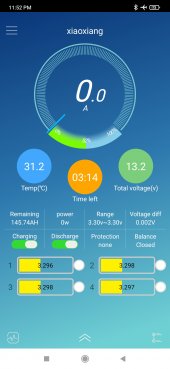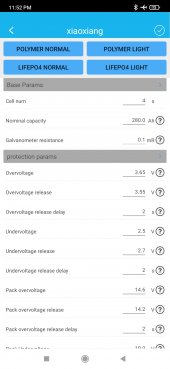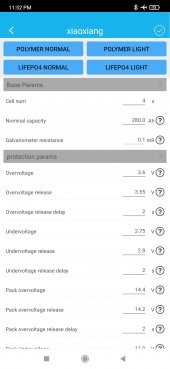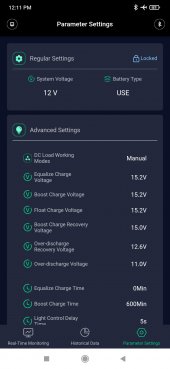Yes 100% accurate, and this can be confirmed just by looking at your typical default threshold settings on your average LFP BMS for example.
An example pulled off of spec sheet for a typical JBD BMS...
View attachment 108672
The high-volt threshold (Overcharge Detection Voltage) at 3.75v /cell, and low-volt threshold (Undercharge Detection Voltage) at 2.7v /cell, which are both considered to be within extreme limits to protect a cell from damage due to some infrequent charge/discharge event, but definitely not within standards (best practices) for repeated cycling in that range to maintain long battery cell life...
As you can see, both of those threshold voltages are well into the high and low red zones in the diagram below (if any kind of decent cell life is the objective):
View attachment 108670
Both the charger profile cycle voltages, and the inverter low-voltage cutoff should always be calibrated to limit SoC movement within the desired high limits and low limits of the battery bank which are within acceptable range for normal operation.
BMS was intended to be 'the last line of defense'...
Hi, another reply from me. I am trying to go over everything and make sure I gain as much knowledge as I can. Thanks for your help and all the information you have been providing. I replied to several of your other posts and you make some great points. I am working on getting the larger wires, nailing down the 1v delta from controller to the battery etc.
With that said, I have to say, and I am not trying to discredit you or anything you say, but, I mean come on man. A single spec sheet that could be from anywhere and anywhen... I have been researching LFP Batteries, their settings, charging profiles, etc and I have NEVER ONCE come across a Spec Sheet that out of whack.
I have 2 batteries, one with programmable BMS and one that has no connectivity or display, a "Lead Acid Drop In Replacement" if you will.
The Programmable Battery with the Bluetooth BMS App has preset defined user profiles and you can also manually adjust many parameters. I took screenshots of LIFEPO4 Normal (Img3) and LIFEP04 Light (Img4), and they are within proper spec. I use the light settings. And it works great, 2 plus years and no issues, top balance healthy pack, no deviation on the cells. Etc.
I do not mean to but heads again, or argue about weather I should use the BMS to turn off the charge cycle or not, I literally don't have any other way to stop the charge cycle. I just replied to Supervstech, who you were replying to to confirm his correctness. I am not judging, and I will not tell you how to operate your system, but I will say, I think I brought up a couple good points; so I will quote them, and I would like to know your take on these points. And if you can, read the terminal voltage of your SCC and Battery. Don't unplug, turn off or disconnect anything, just take a quick looksee. I am trying to get a broader data set. If you can, and don't forget, I do appreciate everyone's help, their input and wisdom. Thanks man.
"
It is too early to make any decisions on my final MPPT Parameter settings until I make sure ALL cables are large enough, and triple check all connections, etc. But I already know that the default LFP setting for this MPPT Controller doesn't cut off the voltage when the battery is full, that is handled by the BMS on the Battery. I ran the system in the default settings for the first week and I charged up the system to full, twice. Both times; the BMS turned off the charging cycle, it literally flipped the charge toggle off, and I could not manually turn it back on until the "Charge Voltage Disconnect Release Voltage" was hit. Then it would toggle charging back on. Or allow me to manually toggle it.
I had a non-programmable Renogy Wanderer 30 Amp LFP Version Charge Controller for 2 years and the only way to stop charging was when the batteries BMS would kick in and stop the charging cycle. That was how it was designed to work and it worked great for 2 year.
This new MPPT charge controller has a "LI" setting that is explicitly for LFP and it too works just like the Renogy Wanderer, the only way the charge cycle stops is when the Batteries BMS kicks in.
This new MPPT also has a "USE" setting for User Programable Parameters, but again, there IS not High Voltage Disconnect setting and the only way the charge cycle is stopped is if the batteries BMS stops the charging into the battery.
I do realize a lot of people in the forum are saying the same thing as you, that I shouldn't use the battery BMS to stop charging, but that is literally how its designed to work. I literally have no other way to stop the charge cycle unless I would sit there and manually do it, and you know that is practically impossible.
And then there is the Wall Chargers that I have, designed for LFP, they do not stop sending current and the only way I know my battery is fully charged is when the BMS says 100% and stops the charging.
And, on top of that, all the advertisements around new LFP batteries talk about "Lead Acid Drop In Replacement" meaning these Batteries are designed to work with a wide range of hardware designed for 12v Lead Acid Equipment. Including Lead Acid Chargers, Inverters, etc - these devices cover a wide rang of usage scenarios and parameters, and LFP batteries with internal BMSs are designed with this in mind, meaning the BMS was designed to be used to disconnect the current once the battery is charged. That, and many other conveniences of modern electronics like cell balancing functions, over-current, over-charge, reverse polarity, over-discharge, etc - all these functions are built in and guaranteed by the battery manufacturers.
If they fail, its the manufacturer who will have to cover the replacement costs, at the least. (And I don't want to get into the minutia of fly by night cheap sellers, etc, that is not the point... though it is a consideration)
With what you have said, as well as so many others in this forum, (thank you by the way) - what do you recommend I do.
What system are you running? Do you have modern hardware? Do you have LFP, or Lead Acid?
What Charge Controller are you using? What is the reading at the posts of your charge controller terminals, and battery terminals during peak sun? Do you see any Vdroop?"
Thanks again.







